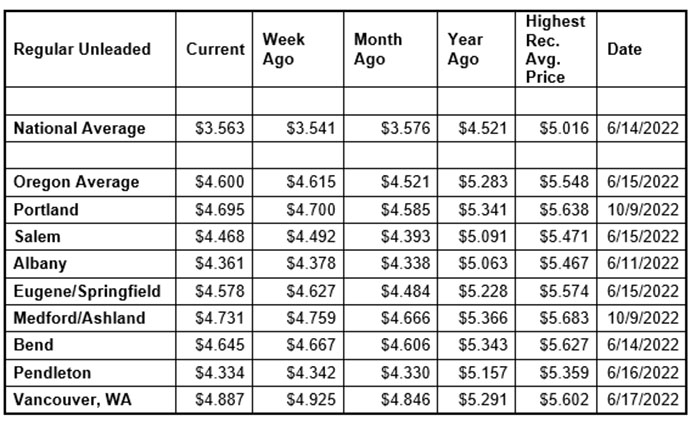The national average for regular is edging up this week, due mostly to higher crude oil prices.
Crude oil climbed above $76 per barrel last week, the highest price since April. But lower demand is keeping gas price hikes in check, and 16 states, including Oregon, are seeing small declines. For the week, the national average rises two cents to $3.56.
The Oregon average dips 1.5 cents to $4.60.
“Crude oil prices have risen from the upper $60s per barrel to the mid-$70s. Demand for gas in the U.S. has dropped nearly 10 percent since the Fourth of July holiday. Normally such a drop would put downward pressure on pump prices, but the higher cost of crude oil is basically canceling that out,” says Marie Dodds, public affairs director for AAA Oregon/Idaho.
Oregon is one of 16 states and the District of Columbia with lower prices now than a week ago. Indiana (+22 cents) has the largest weekly jump. Florida (-7 cents) has the largest weekly decrease. The averages in Connecticut and Massachusetts are flat.
Washington ($4.94) has the most expensive gas in the nation for the fifth week in a row. California ($4.91) is second, Hawaii ($4.69) is third, Oregon ($4.60) is fourth, Alaska ($4.29) is fifth, and Nevada ($4.23) is sixth. These are the six states with averages at or above $4 a gallon, same as a week ago. This week 44 states and the District of Columbia have averages in the $3-range. No state has an average in the $2 range this week.
The cheapest gas in the nation is in Mississippi ($3.01) and Alabama ($3.13). For the 131st week in a row, no state has an average below $2 a gallon.
The difference between the most expensive and least expensive states is $1.92 this week, compared to $1.98 a week ago.
Oregon is one of 29 states with higher prices now than a month ago. The national average is one cent less and the Oregon average is eight cents more than a month ago. Colorado (+28 cents) and Alaska (+23 cents) have the largest monthly jumps. Arizona (-36 cents) has the largest monthly drop.
All 50 states and the District of Columbia have lower prices now than a year ago. The national average is 96 cents less and the Oregon average is 68 cents less than a year ago. West Virginia (-$1.24) has the largest yearly drop. Washington (-30 cents) has the smallest. Last year, crude oil prices and pump prices rose rapidly after the Russian invasion of Ukraine.










